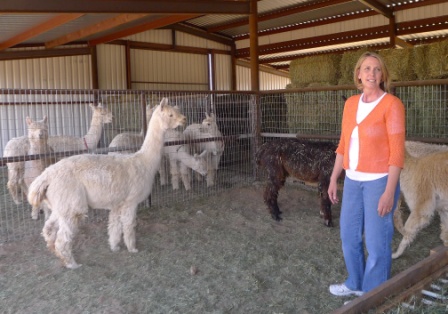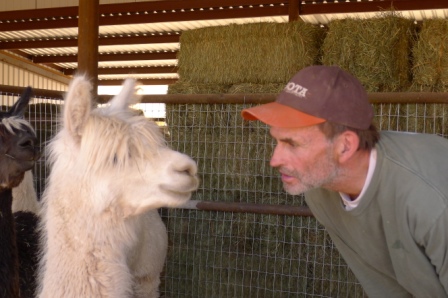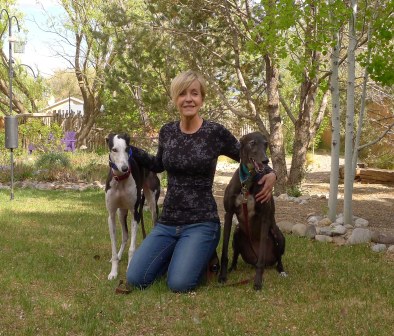A vision in white
If you come across a herd of cotton walking by the ditch, you're not dreaming.
Brad Haslam is.

DEBBIE AND BRAD HASLAM know they are a little extreme as animal nuts go, even for Corrales. Who would start their farm with a brandnew barn, house, and herd of 27 alpaca? They can’t even claim to be innocently bitten by the Corrales bug—they’re both Albuquerque natives.
To see the herd, though, is to get a pretty good idea of how a would-be gentleman farmer might be struck by a dose of enchantment. Woolly and petite, with their flirty eyes, these alpaca are snow-white, a striking vision against the Haslams’ 13 acres of greening pasture between the ditches on the north end of Corrales.
The herd is Suri Alpaca, a once-rare breed that differs from the more wellknown Huacaya for its silky, soft fleece that hangs in dreadlocks rather than fluffing up in a woolly carpet. Suri were reserved for royalty in Incan times, but their popularity in North America—especially since their fleece fetches a higher price—led to one of the boom-and-bust cycles common with exotic livestock.
Brad Haslam confesses that he has always harbored a fantasy about farming. A distributor for Stryker medical devices for three decades, he still works part-time and cycles avidly, but could not get the agricultural bug out of his system. Last year he and Debbie bought the large grassy parcel north of the defunct Corrales Furniture factory, erected a large barn and double-wide trailer to live in, and began building an even larger house.
“We picked alpaca because it’s an exotic animal,” Debbie says. “And we’re soon to have eight grandkids, and alpaca are easy to handle.” Also, the camelids are a lot more personable than goats, Brad notes. Fans know alpaca are charming, friendly, low-maintenance, and always poop in the same spot.

“It’s a hobby,” Brad hastens to add, “and part-time business.” He says
the goal is to sell the babies (cria) and fleece. Ten cria should be
available by June. Named VAME Alpaca Farm after the initials of their
four children, the enterprise is a puzzle to those namesakes, Debbie
says, who probably expected their parents to settle into something more
typical, like touring the West in a big RV.
“When you’re
passionate about it, it’s not really work,” Brad offers—though it turns
out that Debbie, at this point, is doing most of it.
The animals
all have names, and many wear name tags. Debbie is learning their
personalities. A breeder in Santa Fe was going out of business, and “the
deal was to take the whole herd,” Brad says. His modest goal is to earn
enough to cover feed, which is only two bales a day.
Even that
will be taken care of once the pasture, which is planted in a special
alpaca blend, is ready for the animals to range free. VAME will be the
largest Suri Alpaca farm in the Albuquerque area.
Debbie would
like to learn to spin. A Great Pyrenees puppy is learning to be guardian
to the cria. Workmen and trucks travel to and fro, tractors work the
pasture, and the curious woolly beasts are settling into their new
home—as perfect a place as any to be touched by the farming bug.

